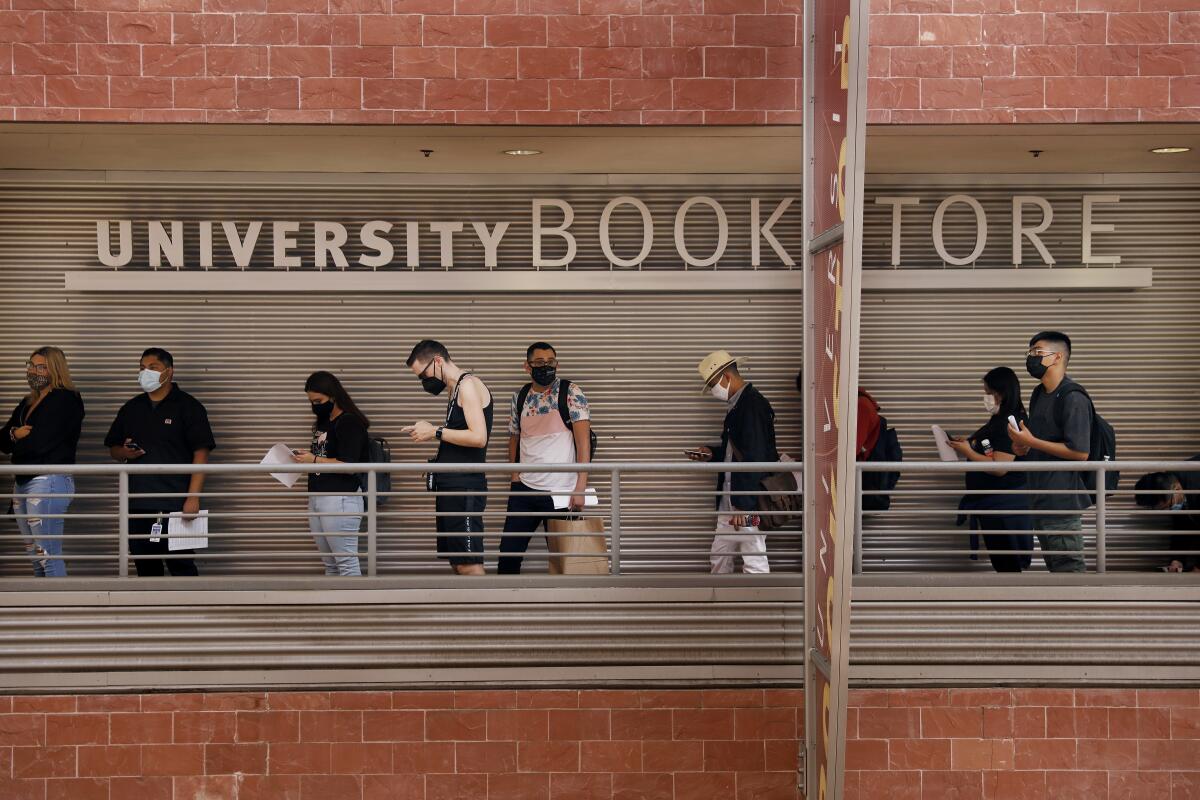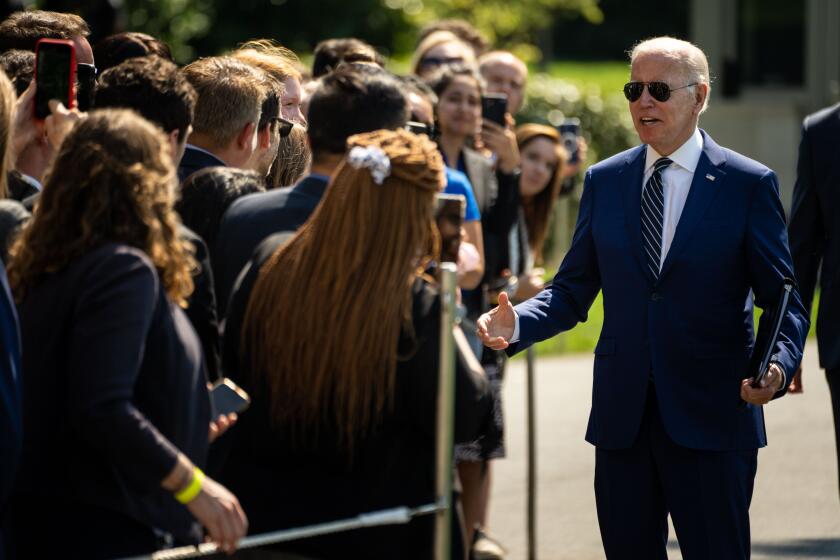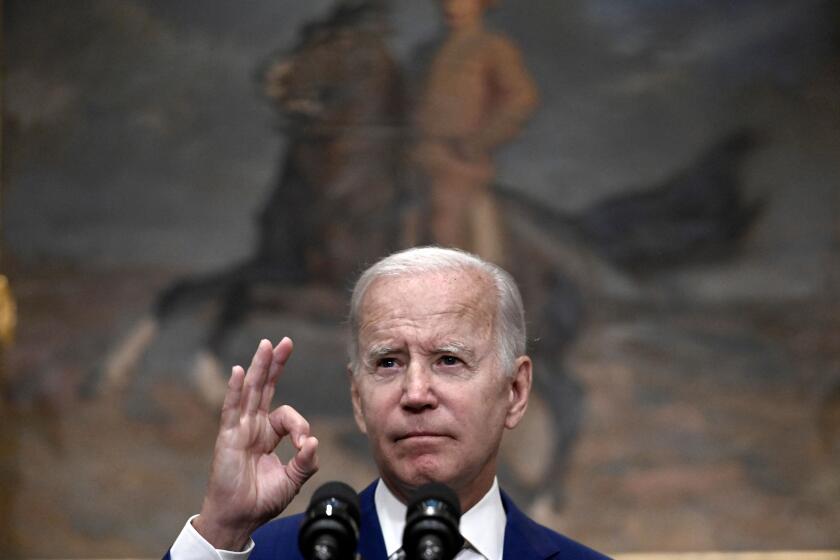Student loan forgiveness: Times journalists discuss Parent Plus loans, taxes and more

- Share via
The announcement Wednesday that the federal government would forgive up to $20,000 in federal student loan debt for many borrowers has sparked conversation about politics, college affordability and the basics of how the program will work.
To dig into these issues and answer your questions, The Times hosted a Twitter Spaces conversation Thursday with staffers Jon Healey, Jessica Roy, Eli Stokols and Debbie Truong. You can listen to a replay anytime.
In a second Twitter Spaces on Sept. 9, Healey spoke with Natalia Abrams of the Student Debt Crisis Center about the prospect of student loan forgiveness being counted as taxable income in California. Listen here.
Here are answers to some of the questions listeners asked during the first Twitter Spaces.
Do Parent Plus loans qualify for forgiveness?
The short answer is yes.
The longer answer is that it depends on income. Yes — if the parents’ income is under $125,000 for people who file their taxes as a single person or under $250,000 for a married couple.
Can current or new students have their debt forgiven?
Current students, yes, if their loans are federal direct loans and they meet the income limits. Stokols, who covers the White House for The Times, said that the cutoff for loan eligibility is July 1, according to a briefing for reporters. Loans originated after that date won’t be forgiven.
And that means students who haven’t started college or taken out loans yet won’t be eligible for loan forgiveness from this program in the future. Nor will current students with eligible loans be able to throw new loans into the forgiveness mix.
The Biden administration’s student loan relief plan is expected to wipe out the debt of 1 million or more Californians. Here’s who is eligible and for how much forgiveness.
What if I’m in default on my student loans?
About 7.5 million people have student loan debts in default. Right now, it’s unclear whether defaulted loans will receive the loan forgiveness the Biden administration announced this week.
Roy, an assistant editor on the Utility Journalism Team, cautioned that being in default is, broadly speaking, bad: It shows up on your credit report and hurts your credit score. Those things make it harder to rent an apartment or qualify for a mortgage, and they make any other debt you take on — like a car loan — more expensive. Being in default can also make you subject to collections practices, fees and wage garnishment.
Back in April, the Biden administration launched the Fresh Start program for borrowers in default. Qualified defaulted borrowers will need to contact the Department of Education’s Default Resolution Group or their loan holders to take advantage of it.
Once you enroll in Fresh Start, your loans come out of default. You will once again be eligible for a number of forgiveness, consolidation and repayment programs, including income-driven repayment plans, which could reduce your monthly payments to as little as $0, depending on your income. Fresh Start will also make you eligible to receive various forms of federal student aid (including Pell Grants and work study) if you need financial help to complete your education. It removes the negative marks from your credit reports and offers one year of protection from collection efforts and fees.
Totally Worth It
Be your money's boss! Learn how to make a budget and take control of your finances with this eight-week newsletter course.
You may occasionally receive promotional content from the Los Angeles Times.
Do I qualify automatically for loan forgiveness?
In some cases, yes. If you are on an income-driven repayment plan and have kept your information up to date, the government already knows how much money you make and is expected to apply the appropriate amount of loan forgiveness to your account.
But if you are on a standard repayment plan — that is, you pay the same amount every month regardless of your income — you should fill out the paperwork the Department of Education will provide in coming weeks. To be notified about updates, sign up for emails from the Education Department.
The White House said Pell Grant recipients would receive twice as much loan forgiveness as other low- and moderate-income borrowers. Do you qualify? Check the Federal Student Aid website.
Is more detail available?
Here are the details the White House has released.
Here’s a fact sheet from the Department of Education.
Healey, who is the senior editor on the Utility Journalism Team, tweeted a link to a Q&A that was held for journalists.
And The Times has covered several aspects of this issue:
- How can you tell if you received a Pell Grant? (And what is a Pell Grant?)
- Who is eligible for the loan forgiveness? And how much?
- How will this affect borrowers in California?
You can expect more coverage in the coming days and weeks as well, including answers to a couple of questions about loan consolidation we heard during the Twitter Spaces conversation.
About The Times Utility Journalism Team
This article is from The Times’ Utility Journalism Team. Our mission is to be essential to the lives of Southern Californians by publishing information that solves problems, answers questions and helps with decision making. We serve audiences in and around Los Angeles — including current Times subscribers and diverse communities that haven’t historically had their needs met by our coverage.
How can we be useful to you and your community? Email utility (at) latimes.com or one of our journalists: Jon Healey, Ada Tseng, Jessica Roy and Karen Garcia.
More to Read
Totally Worth It
Be your money's boss! Learn how to make a budget and take control of your finances with this eight-week newsletter course.
You may occasionally receive promotional content from the Los Angeles Times.













